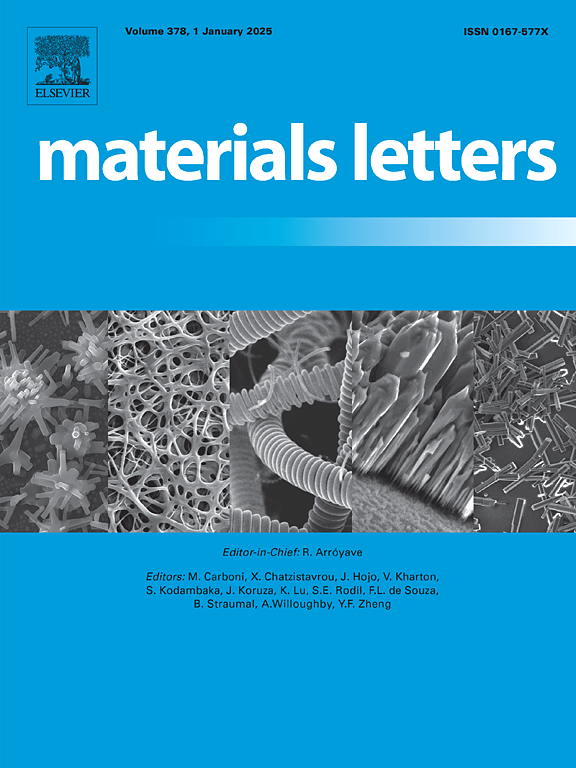核壳结构BFO/CFO纳米复合材料的高效微波吸收
IF 2.7
4区 材料科学
Q3 MATERIALS SCIENCE, MULTIDISCIPLINARY
引用次数: 0
摘要
许多核-壳纳米结构表现出优异的微波吸收性能,而核-壳BiFe3O4(BFO)/CoFe2O4(CFO)纳米复合材料受到的关注有限。本研究重点研究了通过低成本易溶溶胶-凝胶技术制备的核壳结构BFO/CFO纳米复合材料的微波吸收特性。x射线衍射(XRD)分析证实了菱面体BFO和立方尖晶石CFO相的共存,而高分辨率透射电镜(HRTEM)显示了纳米复合材料中BFO-CFO界面清晰的核壳形貌。优化后的CFO负载改善了纳米复合材料的界面极化和阻抗匹配,从而提高了微波吸收能力和有效吸收带宽(EAB)。在窄(1.7 mm)匹配厚度下,50 wt% CFO样品的最小反射损耗(RLmin)为- 35.1 dB(99.97%吸收),EAB为- 4.4 GHz。本文章由计算机程序翻译,如有差异,请以英文原文为准。
Core-shell structured BFO/CFO nanocomposites for efficient microwave absorption
Numerous core–shell nanostructures have demonstrated exceptional microwave-absorption performance, whereas core–shell BiFe3O4(BFO)/CoFe2O4(CFO) nanocomposites have received limited attention. This study highlights microwave-absorption properties of core–shell structured BFO/CFO nanocomposites developed via a low-cost facile Sol-gel technique. X-ray diffraction (XRD) analysis confirmed the coexistence of rhombohedral BFO and cubic-spinel CFO phases, whereas high-resolution transmission electron microscopy (HRTEM) revealed a well-defined core–shell morphology with distinct BFO-CFO interfaces in the nanocomposites. The optimized CFO loading in the nanocomposites improves interfacial polarization and impedance-matching, leading to stronger microwave-absorption and wide effective absorption bandwidth (EAB). Minimum reflection-loss (RLmin) of −35.1 dB (99.97 % absorption) and EAB of ∼ 4.4 GHz were recorded for 50 wt% CFO sample at narrow (1.7 mm) matching-thickness.
求助全文
通过发布文献求助,成功后即可免费获取论文全文。
去求助
来源期刊

Materials Letters
工程技术-材料科学:综合
CiteScore
5.60
自引率
3.30%
发文量
1948
审稿时长
50 days
期刊介绍:
Materials Letters has an open access mirror journal Materials Letters: X, sharing the same aims and scope, editorial team, submission system and rigorous peer review.
Materials Letters is dedicated to publishing novel, cutting edge reports of broad interest to the materials community. The journal provides a forum for materials scientists and engineers, physicists, and chemists to rapidly communicate on the most important topics in the field of materials.
Contributions include, but are not limited to, a variety of topics such as:
• Materials - Metals and alloys, amorphous solids, ceramics, composites, polymers, semiconductors
• Applications - Structural, opto-electronic, magnetic, medical, MEMS, sensors, smart
• Characterization - Analytical, microscopy, scanning probes, nanoscopic, optical, electrical, magnetic, acoustic, spectroscopic, diffraction
• Novel Materials - Micro and nanostructures (nanowires, nanotubes, nanoparticles), nanocomposites, thin films, superlattices, quantum dots.
• Processing - Crystal growth, thin film processing, sol-gel processing, mechanical processing, assembly, nanocrystalline processing.
• Properties - Mechanical, magnetic, optical, electrical, ferroelectric, thermal, interfacial, transport, thermodynamic
• Synthesis - Quenching, solid state, solidification, solution synthesis, vapor deposition, high pressure, explosive
 求助内容:
求助内容: 应助结果提醒方式:
应助结果提醒方式:


